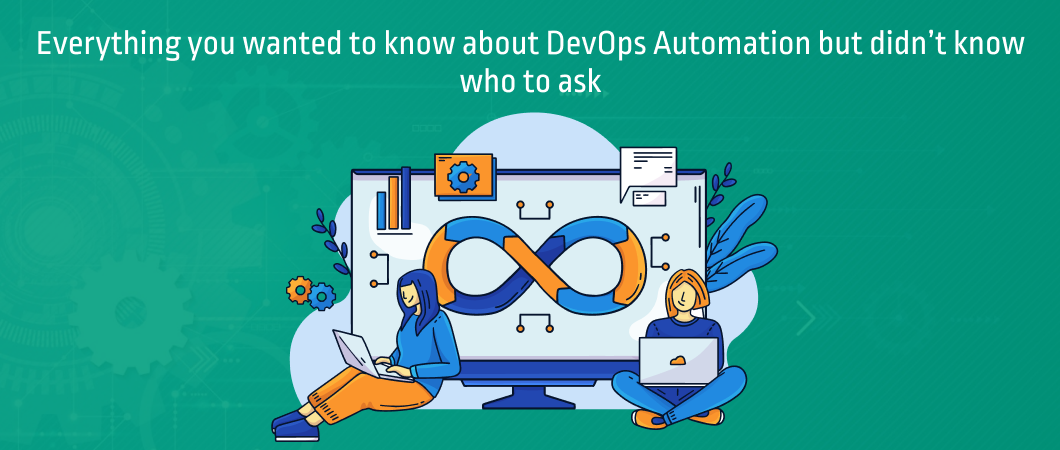The Ultimate Guide to DevOps Automation: Tools, Testing Strategies, and Tactical Tips
The Ultimate Guide to DevOps Automation: Tools, Testing Strategies, and Tactical Tips
The DevOps market is projected to grow at a CAGR of 20% by 2026 globally. Automation is the need of the hour for many enterprises who are seeking to transform their processes digitally and reduce human assistance in routine tasks among other things. DevOps helps them achieve this goal efficiently by combining the efforts of the development and operations teams.
Since “automate everything” is a primary principle of the DevOps model, companies have focussed on incorporating automation right from the deployment of code, to maintaining the applications. More and more enterprises are rejecting the need for compulsory manual effort in many internal activities, and making more room for better innovation-driven ideas and products.
There are plenty of DevOps tools that help enterprises achieve the desired automation while improving their team’s collaboration and productivity. Here’s a peek into what DevOps tools entail and the most popular ones currently.
What are DevOps tools and why do we use them?
Highly reliable tools are a must for every enterprise looking to transform using DevOps. DevOps automation tools help developers automate development processes more efficiently and scale up on innovation quickly.
And it’s important to note that choosing just one tool may not exactly satisfy every need of a business problem. Therefore, enterprises need to make a well-informed decision and choose the tools that best fit their business challenge or automation requirement.
Top DevOps Automation Tools
1. Git
This is the most popular tool amongst software development companies, used by programmers for tracking their changes to source code, and helps with efficient collaboration across teams. It supports non-linear workflows and distributed systems. A noteworthy feature of Git is it allows programmers to trace back to a previous version of the source code seamlessly.
2. Splunk
Splunk helps with data analytics and in providing intelligent insights to the DevOps team. By using the actionable and accurate data provided by Splunk, enterprises can detect and fix problems occurring within their processes rapidly.
3. Docker
Docker is a widely used open-source app containerization platform that hosts a suite of DevOps tools. When Docker is used, programmers can solely concentrate on the development and not worry about the deployment processes or hosting platforms.
4. Kubernetes
Founded by Google, Kubernetes or K8s is an open-source container orchestration platform. While Docker helps with building, sharing, and running individual containerized applications, Kubernetes on the other hand runs many of them across a cluster by automating them at scale. Many enterprises prefer using Docker and K8s simultaneously for faster results.
5. Jenkins
CI/CD is the most crucial part of DevOps and Jenkins is an automation tool for enabling exactly this. An open-source automation server based on Java, it helps with automation, monitoring, and execution of plenty of stages within the CI/CD delivery pipeline. And Jenkins hosts various super-useful plugins specific to almost every programmer or organization’s need.
6. GitHub
GitHub is one of the oldest and most efficient DevOps tools used across organizations globally. GitHub is a web-based collaborative platform with version control that lets users create multiple projects and work together.
7. Ansible
Driving on the concept of infrastructure as code, Ansible by Red Hat is a configuration management tool that is shown to improve the DevOps team’s productivity drastically. This was feasible owing to its success in automating, configuring, and managing the IT infrastructure.
Now that we’ve seen a range of exceptional DevOps tools, let’s shift our attention to the need for enterprises to have a successful DevOps testing plan.
What goes into DevOps Testing?
An enterprise’s DevOps testing plan can be deemed as successful by analyzing the frequency of deployment of applications and the speed at which they release them. As a result of this, their customers are more satisfied since their needs are continuously met and the application is always up to the mark.
The testers in the DevOps model need to focus on extensive test automation to achieve the pace mandated by the CI process. Along with automation, testers need to prioritize using the best agile practices, and running unit and component tests at every stage to ensure optimum application functioning.
Also since collaborative efforts is a core principle in DevOps, not just the testers but everyone else on the DevOps team needs to be responsible for the delivery of the application or services in question. Familiarity with the above automation tools and applications is a must-have technical skill for every DevOps tester.
DevOps Automation Best Practices and Tactics for Proven Success
DevOps automation is pivotal for achieving efficient software delivery and operational excellence. By integrating automation into DevOps practices, organizations can streamline processes, reduce errors, and enhance collaboration across teams. Below are essential tactics and best practices to follow:
- Building a DevOps Mindset: Embrace DevOps as a cultural shift that promotes collaboration between development and operations teams. Training and cultivating a DevOps mindset are crucial for fostering effective communication and accelerating deployments.
- Automating with CI/CD: Implement Continuous Integration (CI) and Continuous Delivery (CD) pipelines to automate building, testing, and deploying code changes. CI/CD ensures that development cycles are rapid, reliable, and consistent, enabling frequent releases.
- Adopting Microservices Architecture: Utilize a microservices-based approach to break down applications into smaller, independently deployable services. This architecture enhances scalability, flexibility, and resilience, enabling faster development cycles and mitigating risks associated with large-scale failures.
- Prioritizing Security (DevSecOps): Integrate security practices into DevOps workflows with a DevSecOps approach. Embed security checks throughout the development lifecycle to identify and remediate vulnerabilities early, ensuring robust protection without compromising speed.
- Infrastructure as Code (IaC): Embrace Infrastructure as Code to automate and manage infrastructure provisioning and configuration. IaC promotes consistency, repeatability, and scalability across environments, reducing manual errors and enhancing agility.
- Monitoring and Logging: Implement comprehensive monitoring and logging practices to gain visibility into application performance and infrastructure health. Automated monitoring alerts and centralized logging facilitate proactive issue detection and resolution.
- Continuous Feedback and Improvement: Foster a culture of continuous improvement by collecting feedback from development, operations, and end-users. Use metrics and analytics to measure performance, identify bottlenecks, and iterate on processes for ongoing optimization.
- Collaborative Tools and Platforms: Utilize collaborative DevOps tools and platforms that support integration, automation, and communication across teams. Choose tools that align with your automation goals and facilitate seamless collaboration and knowledge sharing.
These DevOps automation practices empower organizations to achieve faster time-to-market, higher quality releases, and greater agility in responding to market demands and customer feedback.
Conclusion
DevOps is now known to be a top-notch approach to the much-needed process automation while improving system efficiency and employee productivity. By working with a DevOps adoption partner, you can stay competitive in the DevOps market and continuously deliver robust, optimized, and powerful applications to your customers.
Talk to us today at Forgeahead to explore the DevOps journey and scale your business with the help of our in-house DevOps experts with an impressive track record of successful implementations.
FAQ
How does DevOps Automation improve software delivery?
By automating tasks such as testing, integration, deployment, and infrastructure provisioning, DevOps Automation accelerates the software delivery process. This results in faster time-to-market for new features and updates.
What role does automation play in Continuous Integration/Continuous Deployment (CI/CD)?
Automation is central to CI/CD practices, where it enables frequent code integration, automated testing, and continuous deployment to production environments. This automation ensures rapid and reliable delivery of software updates.
How does DevOps Automation impact team collaboration?
DevOps Automation promotes collaboration by standardizing processes and providing shared tools and visibility across development, operations, and QA teams. This alignment reduces silos and fosters a culture of continuous improvement.
How can organizations get started with DevOps Automation?
Organizations can start by identifying key processes that can benefit from automation, selecting appropriate tools, establishing clear objectives, and gradually implementing automation practices while monitoring and refining them over time.
How does DevOps Automation contribute to scalability and resilience?
By automating provisioning and deployment processes, DevOps Automation allows infrastructure to scale dynamically based on demand. Automated monitoring and recovery mechanisms also enhance resilience by detecting and responding to issues swiftly.



